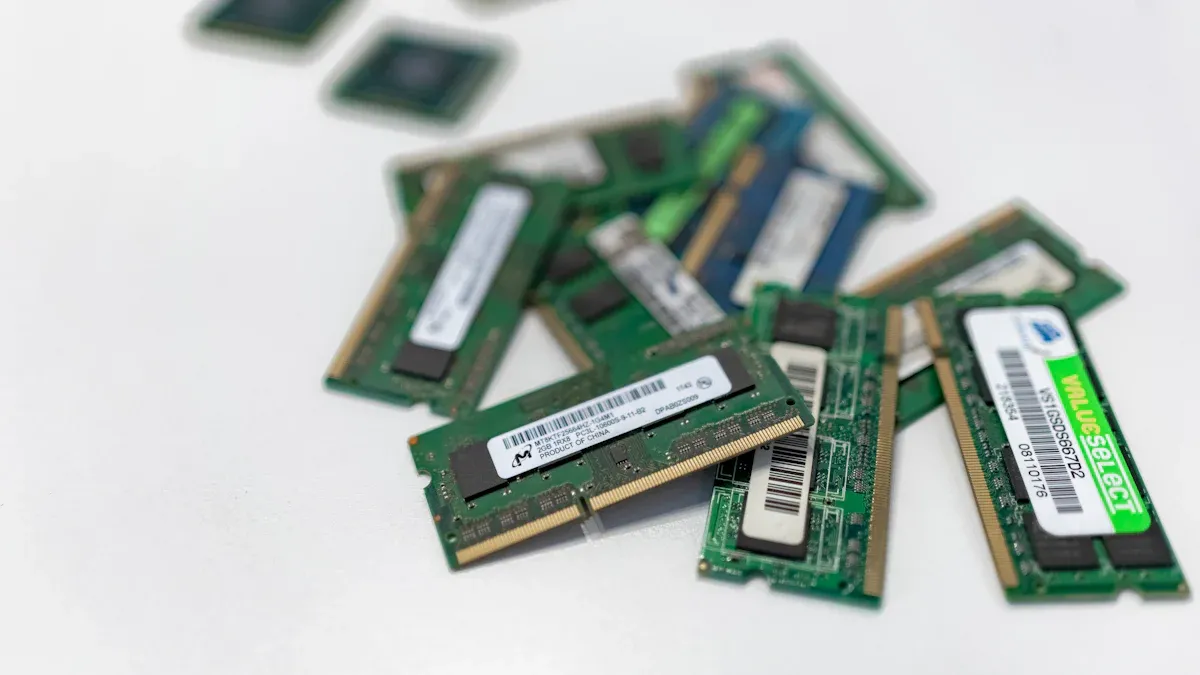
RS485 is a reliable serial communication protocol designed for long-distance data transmission—up to 4,000 feet—even in electrically noisy environments like factory floors. RS485 can transmit data over distances of up to 4,000 feet with speeds ranging from 1,200 to 115,200 bits per second, depending on cable quality and setup. Twisted pair wires reduce interference and keep signals clear. Many devices can share the same network without problems. RS485, also called EIA-485, connects up to 32 devices. It is great for strong and fast data sharing.
Key Takeaways
RS485 is a strong communication system for sending data far, up to 4,000 feet. It works well in factories and industrial places.
Twisted pair wires lower electrical noise. This keeps signals clear and helps devices talk to each other on the same network.
RS485 works with protocols like Modbus and BACnet. These let it link devices and make automation systems work better.
What Is RS485 and How Does It Work?
Definition of RS485
RS485 is a serial communication standard introduced in 1983, designed to support stable and long-distance data transmission. It uses balanced differential signaling, which reduces electrical noise and allows multiple devices to share the same network line. Because of its reliability and cost-effectiveness, RS485 remains a popular choice for industrial and commercial systems.
How RS485 Transmits Data
RS485 sends data using two wires called A and B. The voltage difference between them shows the data. If wire A has more voltage than B, it means "1." If wire B has more voltage than A, it means "0." This method blocks noise because both wires are affected the same way.
RS485 supports two modes: half-duplex and full-duplex. Half-duplex mode transmits data one direction at a time, while full-duplex allows simultaneous two-way communication, requiring additional wiring. RS485 can send data up to 4,000 feet without losing quality. It also sends data fast, up to 10 Mbps, depending on the cable length.
Differential Signaling and Its Benefits
Differential signaling is an important part of RS485. It sends data as voltage differences between two wires. This reduces the effect of electrical noise, making RS485 great for factories. Twisted pair cables help by canceling out interference. Differential signaling allows long-distance data sharing and connects many devices on one network. This ensures strong and clear communication in complex systems.
Tip: Add termination resistors at the ends of the RS485 network. This helps keep signals clear and reduces signal reflections.
Key Features and Wiring of RS485 Communication
Multi-Drop Network Capability
RS485 lets many devices share one communication line. This is useful for factories where devices must work together. In Modbus systems, one device asks a question, and only the right device answers. This keeps communication clear and organized. RS485 can also send messages to all devices at once. This helps when you need all devices to act at the same time.
RS485 integrates well with modern technologies. RS485-to-Ethernet converters enable remote device control while reducing the need for additional cables and ports. This seamless integration makes RS485 a smart choice for factory automation, control systems, and industrial PCs that require reliable serial communication.
Wiring Requirements for RS485
Good wiring is important for RS485 to work properly. Twisted-pair cables are best because they block interference. Resistors at both ends of the network stop signal problems. Bad wiring can cause errors, so follow the correct setup.
For long distances, preemphasis improves data speed. Without it, RS485 sends data at 400 kbps over 4,000 feet. With preemphasis, the speed doubles to 800 kbps. These wiring tips keep RS485 strong and reliable in factories.
Common Protocols: Modbus RTU, BACnet, and More
RS485 supports popular protocols like Modbus RTU and BACnet. Modbus RTU, made in the 1970s, is simple and works well for factory systems. It uses a master-slave setup, which is easy to use. BACnet, created in 1995, is for building systems like air conditioning and lights. It connects devices from different brands and supports many setups.
Feature/Protocol Layer | BACnet (Building Systems) | Modbus (Factory Systems) |
|---|---|---|
Made In | 1995 | 1970s |
Purpose | Building controls | Factory automation |
Speed | Slower but detailed | Faster and simple |
Security | Includes safety features | Basic, no safety features |
Both protocols use RS485’s ability to send data far and avoid noise. This makes them dependable for their specific tasks.
Where RS485 Is Used in Industrial Applications
Automation and Control Systems
RS485 plays a crucial role in automation and control systems, enabling devices like sensors, controllers, and actuators to communicate seamlessly over long distances—ideal for expansive industrial environments. RS485 hubs help stabilize networks by distributing signals to multiple devices, ensuring robust performance in complex setups. These hubs also refresh signals, keeping data clear even with electrical noise.
RS485 is used in robots, motor controls, and security cameras. It supports protocols like Modbus, which connects devices from different brands. RS485’s ability to link many devices on one network makes factories more efficient and scalable.
Energy Monitoring and Management
RS485 is common in energy systems to gather data from meters. It gives real-time information to save energy and cut costs. For example, RS485 allows remote control of devices from one location. It also sends alerts to fix problems quickly, reducing waste and damage.
RS485 works with many protocols, making it flexible for different tools. This flexibility supports smart energy systems and IoT solutions in industries.
Application Area | Benefits |
|---|---|
Remote Monitoring and Control | Real-time data access improves efficiency and lowers costs. |
Data Collection and Analysis | Collects data for trends and better decisions. |
Alarm and Fault Handling | Sends alerts to fix issues fast, saving energy and equipment. |
Building Management Systems
RS485 is key in managing building systems like HVAC and lights. It works with protocols like Modbus RTU and BACnet MSTP to connect devices. For example, RS485 helped link HVAC devices to a controller for better control. This setup made monitoring easier and improved efficiency.
RS485’s ability to block noise and send data far is great for big buildings. It connects many devices on one network, cutting setup costs. Its reliability ensures smooth operation, even in noisy areas.
Is RS485 Still Useful Today?
Why RS485 is Important in Modern Systems
RS485 is still very useful in today’s industries. It is reliable and works well in many setups. RS485 can connect up to 32 devices on one line. This makes it great for systems like HVAC and lighting in buildings. It also sends data up to 4,000 feet, perfect for big factories.
RS485 can send data quickly, up to 10 Mbps for short wires. This speed helps in systems like SCADA and factory automation. Twisted pair cables block electrical noise, keeping data clear. Good grounding makes RS485 even better for noisy places. It is a strong choice for industrial use.
Comparing RS485 to Other Standards
RS485 is better than other systems for distance and noise control. Here’s how it compares:
Feature | RS-232 | RS-422 | RS-485 |
|---|---|---|---|
Data Direction | Both ways at once | Both ways at once | One way at a time |
Max Distance | 50 feet | 4,000 feet | 4,000 feet |
Max Speed | 115.2 kbps | 10 Mbps | 10 Mbps |
Devices Connected | 1 | Up to 10 | Up to 128 |
Signal Type | Single-ended | Differential | Differential |
Ground Needed | Yes | No | No |
RS485 is better for long distances and connecting many devices. It is faster and handles noise well. These features make it a top choice for factories.
RS485’s Future in Industry
RS485 will stay important as industries grow. The market for RS485 devices is growing fast. By 2031, it could reach $1.3 billion, up from $790.46 million in 2024. RS485 modems may also grow from $1.2 billion in 2024 to $2.5 billion by 2033.
Asia-Pacific countries like China and India will lead this growth.
More factories and smart systems will need RS485 technology.
Even as newer technologies emerge, RS485 continues to play an important role in many industries. Its ability to transmit data reliably across long distances and through noisy environments makes it a dependable choice for everything from factory automation to building management. That’s why many industrial PCs still include RS485 ports—to bridge the gap between legacy systems and modern control architectures.
FAQ
How is RS485 different from other standards?
RS485 uses special signals to block noise. It sends data far and connects many devices on one network. RS232 and USB cannot do this.
Can RS485 work without wires?
RS485 needs wires, but you can add wireless modules. This mix gives RS485’s dependability with wireless convenience.
How do you fix RS485 problems?
Check if wires are connected right. Make sure resistors are in place. Confirm device addresses are correct. Use a tool to watch data and find issues.
Is RS485 still commonly used in industrial PCs?
Yes, many industrial PCs still include RS485 ports, either built-in or available through expansion modules. This is because RS485 remains widely used in factory automation, building control systems, and energy monitoring. Its ability to connect multiple legacy devices over long distances with strong noise resistance makes it a key feature in many industrial environments.







